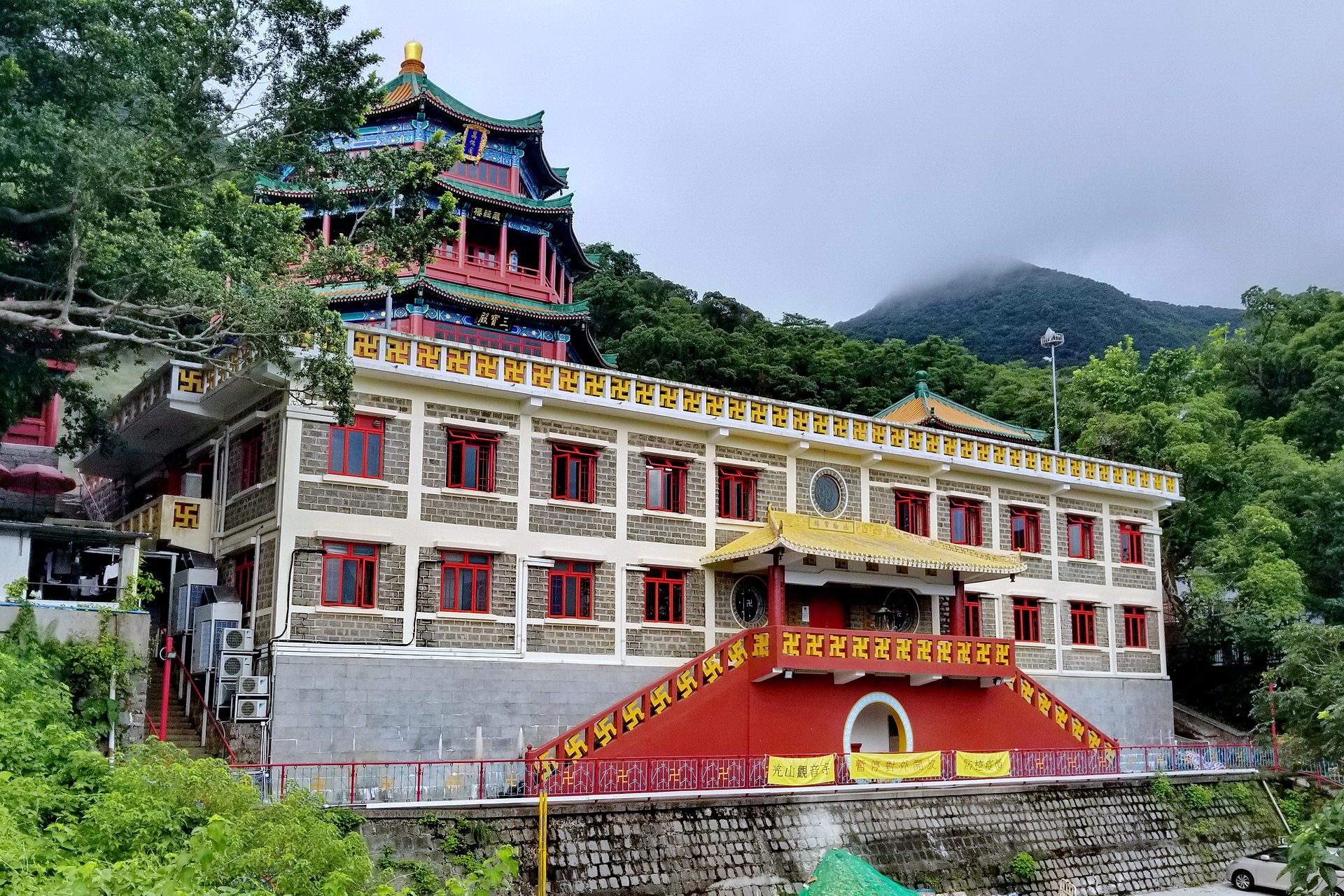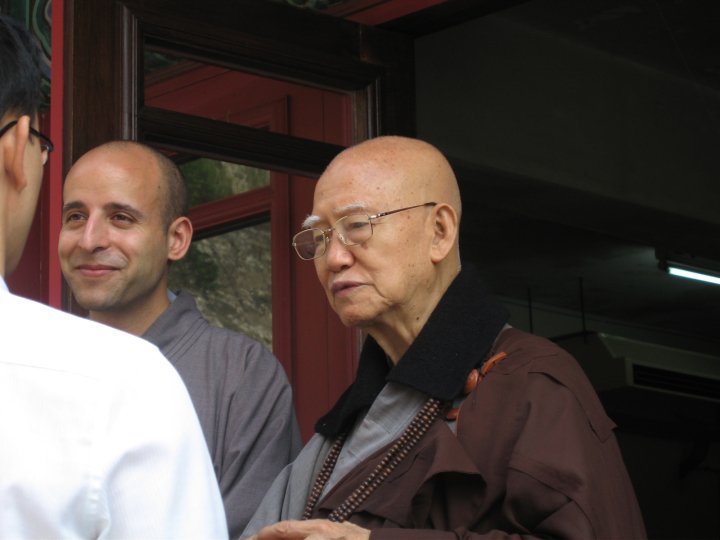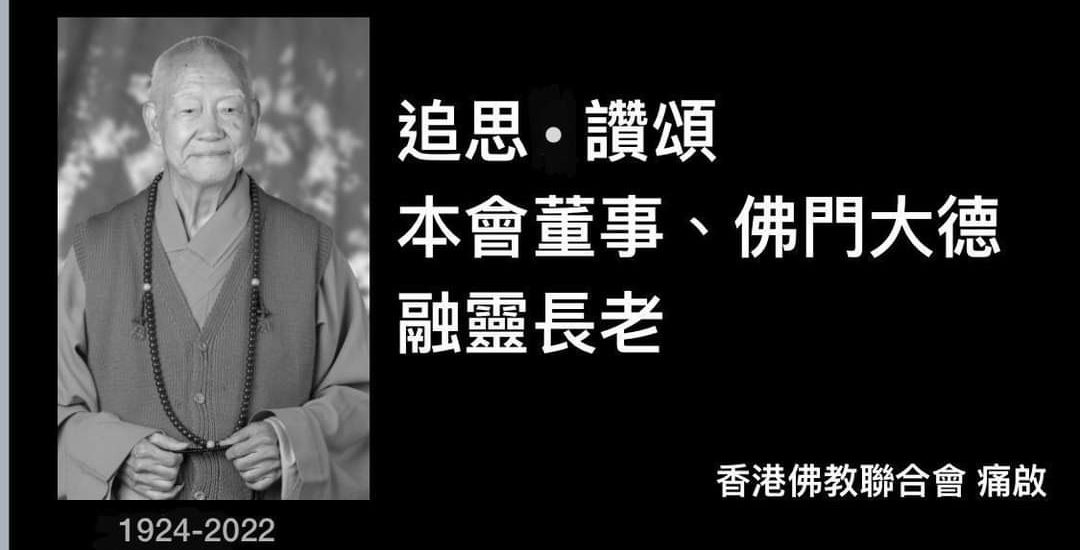Elder Rong Ling, a Chinese Buddhist master who has resided in Hong Kong since 1949, the year the Chinese Civil War ended, passed away peacefully in the afternoon of 10 November 2022. The master had been bedridden and cared for at Chi Lin Nunnery’s Chi Lin Home for the Elderly for the past six years. When he fell ill in 2016, I had written a short post on BDG’s blog, in part for selfish reasons, to ready our community, friends, and myself for his passing. Now that he has truly departed, we should feel no grief, only gratitude for his long presence in this world. His enlightened person is now in Amitabha’s Pure Land. Nevertheless, his loss is deeply felt by all his students and those that know the integral role he played in the history of Buddhism in Hong Kong.
Born in 1924, the master belonged to that revered monastic circle that represented continuity between China’s pre-Civil War Buddhism – a precious vestige of institutional memory – and the stirrings of a localized “Hong Kong Buddhism” that, while unique in identity and cosmopolitanism, was built on the shoulders of these mainland-born Mahayana preceptors.

The truth is that his bonds with his many students were unique in their individual ways. Therefore, every person touched by his extraordinary wisdom, kindness, and warmth will have their own story to tell. Ven. Rong Ling was my root teacher, the first Buddhist master under whom I took refuge and the five lay precepts. The karmic affinity between Sifu and me lay in the bodhisattva truth revealed in the Huayan jing, the Avatamsaka Sutra (commonly seen as the grandest of Mahayana scriptures). Ven. Rong Ling was unique among Hong Kong’s post-war generation of Chinese masters for being well-versed in Huayan thought.
His stewardship of Kwun Yam Temple on Lantau Island, which was founded in 1910, attested to his immersion in Huayan philosophy. Kwun Yam Temple is one of Hong Kong’s oldest and most distinctive Buddhist complexes, with the main shrine in its early main hall still hosting an image of Vairocana Buddha, the cosmic lord of the Avatamsaka. This is highly unusual for conventional Chinese Buddhist temples, which will usually have Amitabha Buddha as their main shrine’s centerpiece. Still, “Amituofo,” the classic Chinese Buddhist invocation, remained Ven. Rong Ling’s favorite refrain. He always returned to the Name, quietly uttering it while we stood watching the trees, or strolling about the grounds of Kwun Yam Temple. He was comfortable in conformity to orthodoxy, for this Mahayana doctrine of Amitabha’s Pure Land is the Buddha of Infinite Light’s guarantee of enlightenment.

At the same time, in 2008, he was mellow and kind enough to meet – and, on the same day, induct into the Mahayana tradition – a hot-headed university student that could barely understand Sifu’s Chinese, nurtured an overzealous and naïve approximation of Huayan thought, and messed up wearing his Buddhist robes. For his generous indulgence I am grateful to him in this life, and will remain so in future ones.
Below I quote the obituary published by the Hong Kong Buddhist Association (of which he had been a director since 1972) in the original Chinese, along with an English translation. May Ven. Rong Ling be reborn in the Pure Land, and we will surely see him again as he comes to deliver beings from suffering.

Remembrance and Tribute
Director of the Hong Kong Buddhist Association, Dharma Gate Great Virtue Elder Rong Ling
Elder Rong Ling’s karma in samsara exhausted on 10 November 2022, revealing the truth of impermanence. He passed away peacefully at the age of 98.
An introduction to Elder Rong Ling:
Elder Rong Ling joined the 19th Session of the Board of Directors of the Hong Kong Buddhist Association in 1972, and has since guided its Dharma affairs as a Director.
The Elder studied in Beijing in his early years. Due to changes in the situation at the time, he went to Hubei in the footsteps of Venerable Master Ti Jing, and then followed the eminent monastic Ven. Ben Huan to study at Nanhua Temple. The Elder came to Hong Kong in 1949, before going to Thailand with Elder Chang Huai and other eminent teachers for practice and study. After returning to Hong Kong, he went to Luk Wu on Lantau Island to practice in seclusion. A year later, upon hearing that Ven. Hai Shan was advocating the recitation of the Avatamsaka Sutra (Huayan Jing) at Kwun Yam Temple and was convening a group of young monastics to hold a Dharma assembly centered on the Sutra, the Elder went to recite the Sutra and to study under Ven. Hai Shan. After Ven. Hai Shan passed away, the Elder was elected by great masters of various monasteries to take charge of temple affairs of the Kwun Yam Temple as its second Abbot.
The Elder also served in positions including Director of the Hong Kong Buddhist Sangha Association and Head of its Membership Division. He resided in Hong Kong for more than 70 years and during this time he endeavored to promote the Dharma, cared for the community, and blessed and gave joy to sentient beings. Now that the Elder has gone to the Pure Land, a mainstay of our Buddhist community is broken and lost. We can only hope that the Grand Master would not abandon sentient beings of this secular world and would one day return on vows to bring sentient beings to enlightenment.
Announced with heavy hearts by the Hong Kong Buddhist Association
10 November 2022
追思讚頌
本會董事、佛門大德融靈長老
融靈長老於公元二零二二年十一月十日住世緣盡,示現無常,安詳捨報,世壽九十八歲。
融靈長老簡介:
融靈長老於1972年加入香港佛教聯合會第十九屆董事會,一直擔任董事公職,指導法務進行。
長老早年在北京參學,後因時局變化,隨體敬老和尚前往湖北,再隨本煥老和尚到南華寺修學。長老於1949年來港,曾與暢懷長老等大德轉赴泰國參學,返港後在大嶼山鹿湖隱廬修行。一年後,得聞海山法師在觀音寺倡誦《華嚴經》,正召集一班年輕法師辦華嚴法會,長老於是前往隨海山法師誦經學習。海山法師圓寂後,長老於1965年被諸山長老推舉為觀音寺第二任住持,主理寺務。
長老亦曾任香港佛教僧伽聯合會董事兼會員部主任等職。長老卓錫香江七十餘載,致力推動佛法弘傳,關心社會,利樂有情。今長老往生蓮邦,佛門棟折砥柱,緇素慟失津梁,惟願老和尚不捨娑婆眾生,不棄眾苦有情,他日乘願再來,普度眾生。
香港佛教聯合會痛啟
二零二二年十一月十日
Related blog posts from BDG


